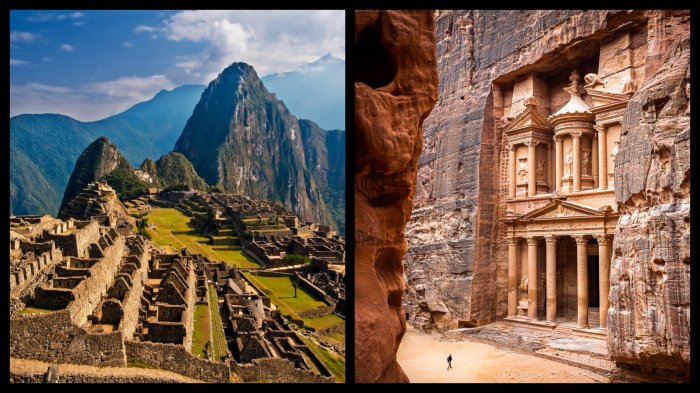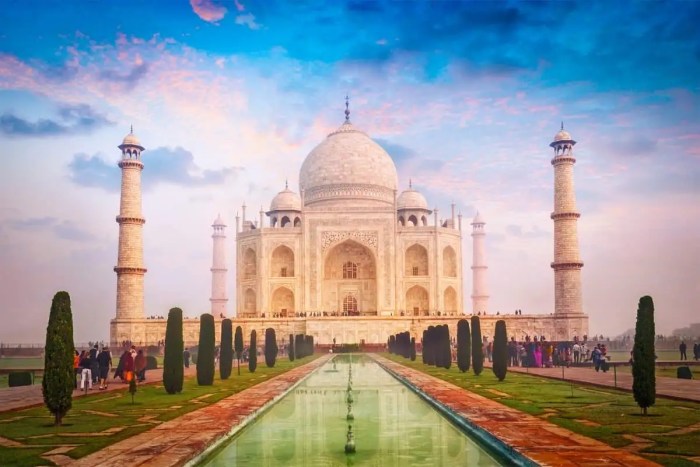UNESCO World Heritage Sites stand as beacons of cultural and natural significance, offering a glimpse into the wonders of our planet. From ancient ruins to breathtaking landscapes, these sites embody the diversity and richness of human history and the natural world. Let’s delve into the fascinating world of UNESCO World Heritage Sites, exploring their criteria, threats, and the importance of sustainable tourism.
Definition and Overview: UNESCO World Heritage Sites
UNESCO World Heritage Sites are places of outstanding universal value that have been designated for preservation and protection by the United Nations Educational, Scientific and Cultural Organization (UNESCO). These sites are recognized for their cultural, historical, natural, or scientific significance, and are considered to be of exceptional importance to humanity.
The criteria used to designate sites as World Heritage Sites include:
- Outstanding universal value
- Authenticity and integrity
- Protection and management measures
- Community involvement
As of 2023, there are over 1,150 World Heritage Sites in 167 countries around the world. These sites include cultural landmarks such as the Great Wall of China and the Taj Mahal, natural wonders such as the Grand Canyon and the Great Barrier Reef, and mixed sites that combine both cultural and natural elements, such as Machu Picchu.
Cultural Heritage Sites

Cultural heritage sites are those that have been recognized for their outstanding cultural, historical, or scientific value. These sites can include anything from ancient ruins to religious monuments to natural wonders. Once a site is designated as a World Heritage Site, it is protected by international law and given funding to help preserve it.
There are many different types of cultural heritage sites around the world. Some of the most famous include the Great Wall of China, the Taj Mahal, and the Pyramids of Giza. These sites are all important examples of human culture and history, and they attract millions of visitors each year.
Preservation and Protection
Preserving and protecting cultural heritage sites is essential for ensuring that they are available for future generations. There are a number of different measures that can be taken to protect these sites, including:
- Restricting access to the site
- Implementing conservation measures
- Educating the public about the importance of the site
- Providing funding for preservation
Natural Heritage Sites

UNESCO has designated numerous natural heritage sites worldwide, recognizing their exceptional geological, ecological, and scenic significance. These sites are protected to ensure their preservation for future generations.
Geological Heritage Sites
These sites showcase unique geological formations, providing insights into Earth’s history and processes. Examples include:
- Grand Canyon National Park (USA): A vast canyon carved by the Colorado River, exposing layers of sedimentary rock dating back millions of years.
- Giant’s Causeway (UK): A coastal area featuring thousands of hexagonal basalt columns formed by ancient volcanic activity.
Ecological Heritage Sites, UNESCO World Heritage Sites
These sites are renowned for their rich biodiversity and unique ecosystems. Examples include:
- Galapagos Islands (Ecuador): A volcanic archipelago known for its endemic species, including giant tortoises, marine iguanas, and Darwin’s finches.
- Great Barrier Reef (Australia): The world’s largest coral reef system, supporting an incredible diversity of marine life.
Scenic Heritage Sites
These sites offer breathtaking natural beauty, inspiring awe and wonder. Examples include:
- Yosemite National Park (USA): A mountainous area famous for its granite cliffs, giant sequoia trees, and cascading waterfalls.
- Plitvice Lakes National Park (Croatia): A series of cascading lakes connected by waterfalls, surrounded by lush forests.
Protecting these natural heritage sites is crucial for several reasons. They serve as:
- Scientific laboratories: Natural wonders that provide insights into geological, ecological, and evolutionary processes.
- Educational resources: Living classrooms that foster understanding of the natural world and its conservation.
- Economic assets: Tourist destinations that generate revenue and support local communities.
- Cultural and spiritual symbols: Places that hold deep cultural and spiritual significance for people around the world.
Mixed Heritage Sites
Mixed Heritage Sites are designated by UNESCO as sites that combine both cultural and natural elements. These sites represent a harmonious relationship between humanity and nature, showcasing the ways in which human activity has shaped the natural landscape and how nature has influenced cultural traditions.
Examples of Mixed Heritage Sites
- Plitvice Lakes National Park, Croatia: A stunning natural landscape with 16 cascading lakes, waterfalls, and lush forests, along with historical and cultural landmarks such as monasteries and villages.
- Srebarna Nature Reserve, Bulgaria: A wetland ecosystem with a rich biodiversity, including rare bird species, combined with cultural traditions of fishing and reed harvesting.
- Mount Etna, Italy: An active volcano with unique geological features and volcanic landscapes, alongside historical and cultural significance as a source of inspiration for art and literature.
Challenges and Opportunities in Managing Mixed Heritage Sites
Managing Mixed Heritage Sites presents both challenges and opportunities. One challenge is the need to balance the preservation of both cultural and natural elements, ensuring that one does not compromise the other. Another challenge is the potential for conflicting interests between different stakeholders, such as tourism development and environmental protection.
However, Mixed Heritage Sites also offer unique opportunities for collaboration and cooperation between different disciplines and stakeholders. By bringing together experts in cultural heritage, natural sciences, and tourism, these sites can foster a better understanding of the interconnections between humanity and nature.
Threats to World Heritage Sites

World Heritage Sites are under constant threat from a variety of natural and human-induced factors. These threats can damage or destroy the cultural and natural heritage that these sites represent.
Many of the world’s most remarkable natural and cultural treasures are designated as UNESCO World Heritage Sites. These sites attract millions of visitors each year, but it’s important to remember that responsible tourism is essential to preserving these precious places.
One way to do this is to stay in eco-lodges , which are designed to minimize their environmental impact. Eco-lodges often use sustainable building materials, energy-efficient appliances, and water conservation measures. They also support local communities and promote cultural preservation.
By choosing to stay in an eco-lodge, you can help to protect UNESCO World Heritage Sites for future generations.
Natural disasters, such as earthquakes, floods, and hurricanes, can cause significant damage to World Heritage Sites. For example, the 2015 Nepal earthquake caused extensive damage to the Kathmandu Valley, a UNESCO World Heritage Site. The earthquake destroyed many historic buildings, including the iconic Dharahara Tower.
Pollution
Pollution is another major threat to World Heritage Sites. Air pollution, water pollution, and soil pollution can all damage the cultural and natural heritage of these sites.
UNESCO World Heritage Sites encompass cultural and natural landmarks of exceptional significance. Some of these sites, such as the Great Barrier Reef, offer breathtaking scuba diving locations. Exploring these underwater wonders allows visitors to witness diverse marine life and pristine ecosystems.
In turn, the protection of these sites as UNESCO World Heritage Sites ensures their preservation for future generations to enjoy and appreciate.
For example, air pollution from vehicles and factories can damage the stonework of historic buildings. Water pollution from sewage and industrial waste can harm aquatic ecosystems and damage coral reefs.
Human Activity
Human activity is also a major threat to World Heritage Sites. Unsustainable tourism, logging, mining, and agriculture can all damage the cultural and natural heritage of these sites.
UNESCO World Heritage Sites offer a glimpse into our planet’s rich history and diverse cultures. But beyond the awe-inspiring architecture and ancient ruins, there’s a world of adventure waiting to be discovered. For those seeking an adrenaline rush, consider incorporating extreme sports vacations into your itinerary.
From rock climbing and white-water rafting to zip-lining and paragliding, these activities will add an unforgettable dimension to your exploration of UNESCO World Heritage Sites.
For example, unsustainable tourism can lead to overcrowding, which can damage fragile ecosystems. Logging and mining can destroy natural habitats and damage cultural landscapes.
To mitigate these threats, UNESCO has developed a number of measures to protect World Heritage Sites. These measures include:
- Establishing buffer zones around World Heritage Sites to protect them from development.
- Developing management plans to guide the use of World Heritage Sites.
- Providing financial assistance to countries to help them protect World Heritage Sites.
- Raising awareness of the importance of World Heritage Sites and the threats they face.
Sustainable Tourism at World Heritage Sites

Preserving World Heritage Sites while accommodating tourism is a delicate balance. Sustainable tourism practices are crucial to protect these invaluable treasures for future generations.
Managing tourism at World Heritage Sites presents both benefits and challenges. On the one hand, tourism can provide economic benefits to local communities and raise awareness about the importance of cultural and natural heritage. On the other hand, it can also lead to overcrowding, pollution, and damage to the sites.
Best Practices for Sustainable Tourism
To ensure sustainable tourism at World Heritage Sites, several best practices should be implemented:
- Limit visitor numbers: Controlling the number of visitors helps prevent overcrowding and damage to fragile sites.
- Educate visitors: Providing information about the site’s significance and conservation efforts encourages responsible behavior.
- Use sustainable transportation: Promoting walking, cycling, or public transportation reduces air pollution and traffic congestion.
- Promote local businesses: Supporting local businesses helps distribute tourism benefits and preserves local culture.
- Respect local customs: Encouraging visitors to be mindful of local traditions and dress codes fosters cultural understanding.
- Monitor and evaluate: Regularly assessing the impact of tourism and adjusting strategies as needed ensures ongoing sustainability.
Examples of successful sustainable tourism initiatives at World Heritage Sites include the Great Barrier Reef Marine Park in Australia, which implements visitor quotas and educational programs, and the Galapagos Islands in Ecuador, which has strict regulations on visitor numbers and activities.
Final Summary
UNESCO World Heritage Sites are not merely relics of the past but living testaments to the power of human creativity and the beauty of our planet. Their preservation is essential for future generations to appreciate and learn from the legacy of our ancestors and the wonders of the natural world.
Answers to Common Questions
What is the criteria for a site to be designated as a UNESCO World Heritage Site?
Sites must meet at least one of ten selection criteria, including cultural, historical, architectural, or natural significance, and demonstrate outstanding universal value.
What are some examples of cultural UNESCO World Heritage Sites?
The Great Wall of China, the Taj Mahal, and the Colosseum are just a few examples of cultural UNESCO World Heritage Sites.
Why is sustainable tourism important at UNESCO World Heritage Sites?
Sustainable tourism helps preserve these sites for future generations by minimizing the impact of tourism on the environment and local communities.